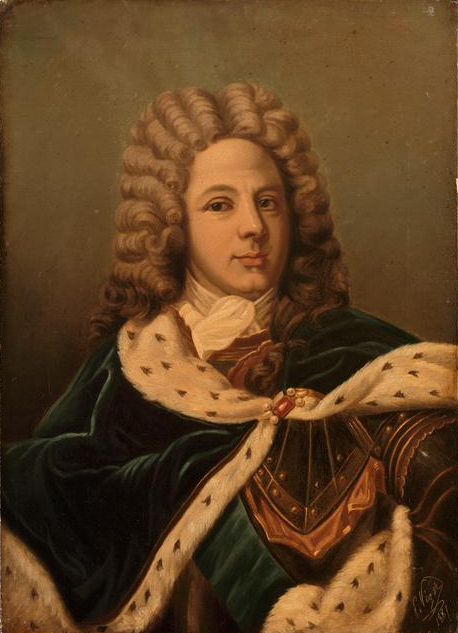Louis de Rouvroy, Duc de Saint-Simon
 Born 16 January, 1675; died in Paris, 2 March, 1755. Having quitted the military service in 1702, he lived thereafter at the Court, becoming the friend of the Ducs de Chevreuse and de Beauvilliers, who, with Fenelon, were interested in the education of the Duke of Burgundy, grandson of Louis XIV. At the death of Louis XIV, he was named a member of the council of regency of the young king, Louis XV, and in 1721 was sent as ambassador to Madrid. When the Duke of Bourbon became minister, December, 1723, Saint-Simon went into retirement. It was principally between 1740 and 1746 that he wrote his celebrated “Memoirs”. As a history of the reign of Louis XIV they are an extremely precious document. The edition with commentary by Boislisle, and of which twenty-two volumes have already appeared (1911), is an incomparable monument of learning. Saint-Simon aired his hatreds, which were bitter and numerous; he was an adversary of equality, which he described as “leprosy”; he dreamt of a kind of chamber of dukes and peers which would control and paralyze royal despotism, and allow the States-General to assemble every five years to present the humble remonstrances of the people.
Born 16 January, 1675; died in Paris, 2 March, 1755. Having quitted the military service in 1702, he lived thereafter at the Court, becoming the friend of the Ducs de Chevreuse and de Beauvilliers, who, with Fenelon, were interested in the education of the Duke of Burgundy, grandson of Louis XIV. At the death of Louis XIV, he was named a member of the council of regency of the young king, Louis XV, and in 1721 was sent as ambassador to Madrid. When the Duke of Bourbon became minister, December, 1723, Saint-Simon went into retirement. It was principally between 1740 and 1746 that he wrote his celebrated “Memoirs”. As a history of the reign of Louis XIV they are an extremely precious document. The edition with commentary by Boislisle, and of which twenty-two volumes have already appeared (1911), is an incomparable monument of learning. Saint-Simon aired his hatreds, which were bitter and numerous; he was an adversary of equality, which he described as “leprosy”; he dreamt of a kind of chamber of dukes and peers which would control and paralyze royal despotism, and allow the States-General to assemble every five years to present the humble remonstrances of the people.

Château de la Ferté-Vidame where Louis de Rouvroy, Duke of Saint-Simon lived. Painting is at the Boston Museum of Fine Arts.
Whatever the historical value of the “Memoirs” may be, they are, by their sparkling wit, one of the most original monuments of French literature; and the “Parallele des trots premiers rois Bourbons”, written by Saint-Simon in 1746, the year in which he finished the record of the reign of Louis XIV, is an admirable piece of history. On all religious questions he should be read with great precaution. Very hostile to the Jesuits, and favorable to the Jansenists, he contributed greatly to the creation of legends concerning personages such as Mme de Maintenon and Michel Le Tellier. These legends had a long existence. The reproach, historically false, of having instigated the violent measures of persecutions against the Jansenists, which he hurled against Le Tellier, was all the more strange coming from his pen, since Saint-Simon himself, on the day following the death of Louis XIV, was one of the most rabid in demanding of the regent severe measures against Le Tellier and other Jesuits. Father Bliard has shown how much care is necessary in judging Saint-Simon’s assertions regarding the religious questions of his day. The historian Emile Bourgeois, who can not be charged with prejudice in favor of religion, wrote in his turn, in 1905: “History has given up the habit, too hastily acquired, of pinning her faith to the word of Saint-Simon.” And Bourgeois proved how inaccurate were the statements of Saint-Simon by showing what use the latter made in his “Memoirs” of documents of the diplomatist Torcy.
SAINT-SIMON, Memoires, ed. BOISLISLE (22 vols., Paris 1876-1911); SAINT-SIMON, Ecrits inedits, ed. FAUGERE (6 vols. Paris, 1880-3); SAINT-SIMON, Lettres et depeches sur l’ambassade d’Espagne, 1721 1722, ed. DRUMONT (Paris, 1880); BASCHET, Le duc de Saint-Simon, son cabinet et ses manuscrits (Paris, 1874); CHERUEL, Saint-Simon considere comme historien de Louis XIV (Paris, 1865); BOISSIER, Saint-Simon (Paris, 1892); BLIARD, Les memoires de Saint-Simon et le Pere Le Tellier (Paris, 1891); BOURGEOIS, La collaboration de Saint-Simon et de Torcy, etude critique sur les Memoires de Saint-Simon in Revue historique, LXXXVII (1905; PILASTRE, Lexique de la langue de Saint-Simon (Paris, 1905).
GEORGES GOYAU






